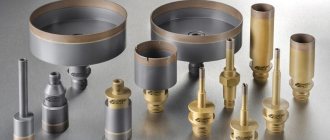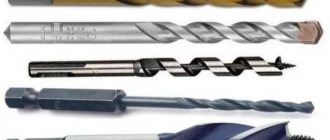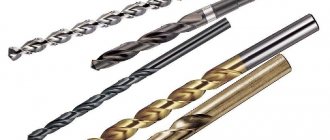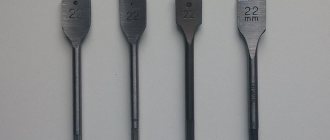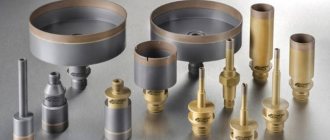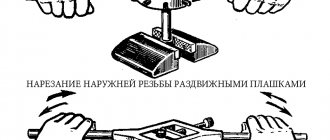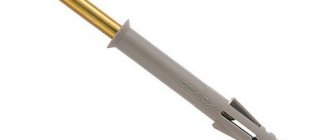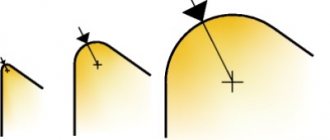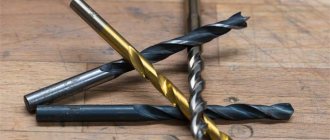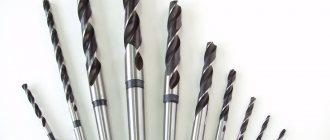Beton-House.com
Website about concrete: construction, characteristics, design. We combine the experience of professionals and private craftsmen in one place
Set of drills of different diameters
Concrete is the most versatile material used in home construction. Therefore, there are often cases when it is necessary to make holes in the concrete surface when laying cables or wires, installing equipment and furniture.
This cannot be done with a regular drill due to the high strength of the material. Only special concrete drills or drills can provide the required result. The article will tell you the types of tools, their features and methods of use.
What is processed with a drill and what with a drill?
These cutting tools can be used to make holes or indentations in almost anything:
- wood and materials based on it (chipboard, OSB, fiberboard, etc.);
- plastic;
- metal;
- stone;
- ceramics;
- brick, concrete and so on.
The difference between a drill and a drill is that it is usually used for processing durable, non-shock-absorbing materials - concrete, stone. A drill is better suited if you need to drill through softer and more elastic materials: wood, plastic. Metal, although it has great strength, is an elastic, springy material, so it is also processed with a drill. Let's look at what this is connected with below.
Comparison
Drills have a large number of varieties. Some are intended exclusively for processing wood and plastic, others are universal and can be used when drilling holes even in brick and concrete, when the use of a drill is impractical for some reason. They differ in the design of the cutting edge, the number of chutes for removing chips or other waste to be removed (concrete dust, etc.). Processing of material by drilling is carried out as follows: the drill rotates around its axis at high speed, the cutting edge enters the material being processed, and waste is discharged through the chutes.
To drill large-diameter holes, drills of a special design are used, which among experts have the slang name “crown”. They are used for processing soft materials (wood, plastic) and are hollow drills. For processing tiles, a special type of drill is also used, which has received the unofficial name “feather”. Such drills usually have a diameter of no more than 10 millimeters.
"Feather"
The fundamental difference between a drill and a drill is that it is designed for processing materials using a rotary impact method. That is, during operation, the drill performs not only rotational (around the axis), but translational (along the axis) movements. This processing method allows you to punch holes in durable materials, the processing of which with drills is impossible or very difficult. The drill tip usually has a slightly rounded working edge, which allows you to increase its working life. Using a drill, you can punch holes up to 1000 mm (1 meter) long, however, the work is carried out in three stages with a gradual increase in penetration depth.
Typically, a drill and a drill differ in the type of shank (that part of the tool that is mounted in the chuck). The drill, as a rule, is simply clamped with three jaws. And for the drill, there is a special chuck that allows the working tool to move along the axis of rotation. There are electric drills with a chiselling function that use a conventional jaw chuck, but practice has shown that in comparison with hammer drills that use a drill, they are ineffective.
Drills and drills for concrete: differences and application features
A drill is a cutting tool for creating through or blind holes in a material, as well as for increasing the diameter of existing holes (drilling operation).
Different types of drills are designed to work with specific materials: metals, plastics, natural or artificial stone, brick, concrete pavement, etc.
It should be noted that, unlike end mills, drills cannot move along the workpiece and remove material from the surface - they are designed only for axial load.
There are drills of other designs (where a conical or tetrahedral shank is used instead of a cylindrical one, and the cutting cone has a tricky shape). However, the twist drill described above is the most versatile for a wide range of jobs in industry and construction.
Structurally, the drill is:
- cutting cone (in the front part) with sharp edges - the sharpening angle affects the characteristics of the drill and is determined by the type of material being processed;
- spiral grooves for removing chips from the cutting area - their shape determines the speed of chip removal and drilling performance (as well as heating of the tool itself);
- and a smooth cylindrical shank for attaching the drill to the tool chuck.
Using a drill
Drills are suitable for creating new blind and through holes and increasing the diameter of existing ones. There are several types of drills:
- Twist drills - for wood, metal, stone. The most common type of drill. Their design feature is the presence of a corkscrew-shaped gutter. Twist drills are suitable for drilling holes on flat surfaces.
- Steel drill bits are an excellent option for wood and plastic. These are inexpensive products that are used for soft materials. In some cases, a steel drill bit can work with brick or metal, but wears out quickly. Accordingly, you can’t count on reusable use.
- HSS drills are slightly stiffer and can drill through harder materials faster and without dulling. They contain heat-resistant alloys that can withstand high temperatures.
- Titanium drills. Due to the titanium coating they have a golden color. Titanium is used for drilling hard materials. These drill bits will not be useful when working with wood or plastic.
- Masonry drills have a sealed corkscrew. The tip has the shape of an arrow. They are commonly used in hammer drills to grind down brickwork as they cut through it. These drills are best for making holes in stone foundations.
Drill bits for concrete and metal
To drill a hole of a certain size, you need to take a drill of the appropriate diameter. However, in addition to the design dimensions (diameter and length of the spiral part), drills differ in the type of cutting cone. In accordance with this, drills are designed to work with certain materials:
- plastic (metals, plastic, plexiglass, textolite, etc.);
- fragile (concrete, stone, inorganic glass, ceramics, etc.).
- Wood drills (perks) can be classified into a separate category. Such drills are characterized by the presence of a sharp tip, which facilitates initial penetration into the material.
Impact drilling
There are special lines of cutting tools for impact drills. They differ from conventional drills, firstly, in the increased hardness of the material - for hammer drills, drills are made of high-speed, carbon or alloy steel (possibly with high-hardness brazing on the cutting edges).
The second difference is the shape of the drill and/or grooves that remove chips (feather or centering grooves are found - with spiral or straight grooves).
And finally, the third (perhaps the main) difference is the shape of the shank. To facilitate installation of the drill into the hammer drill chuck (while simultaneously guaranteeing strict alignment during operation), the shank of such a tool has special grooves. Such a system is called SDS, which translated from German stands for “insert, turn and go.” This is exactly how the SDS drill is attached to the hammer drill chuck - quickly, easily and reliably (no need to look for keys and make efforts to tighten it, as in the three-jaw chuck of a conventional drill).
It should be noted that hammer drills are often called drills. This emphasizes the obvious design differences (the presence of the same SDS shank) and the general purpose - the use of a drill for drilling with impact loading.
The SDS shank has varieties:
- SDS-plus is currently the most common type of tool with a shank diameter from 10 to 40 mm. The fastening system includes four grooves on the shank (a pair of guides and two for fixing). The minimum length of drills with SDS-plus shanks is from 110 mm (and no more than 1 m). Diameter – from 4 to 32 mm. SDS-plus drills are mainly used on lightweight hand-held hammer drills.
- SDS-max - this type of shank is used for large-diameter tools (over 20 mm), intended for powerful, heavy drilling machines. The shank with a diameter of 18 mm has three open grooves and two closed ones (the standard recess in the chuck is 90 mm).
How to work with a drill and drill: rules
To avoid accidents and breakdowns, it is important to follow a few simple rules when working with the tool. Let's look at a few main ones:
- Secure the drill blank with a crowbar. This will minimize chipping if the drill breaks. This clause does not apply to twist drills.
- The drill should make the hole gradually. Don't use force to try to do the job faster than the drill can. Most often, this leads to overheating and even burning of the instrument.
- Check that the head is securely attached. If possible, use a drill press and secure the part you are drilling to. When using a portable drill, clamp the workpiece and hold the drill with both hands.
- Before starting work, the drill is securely fixed in the drill chuck, or the drill in the hammer drill.
- When drilling, you should not leave your eyes unprotected; use special glasses.
- Remove chips from the hole while drilling. When working with metal, do not forget that its shavings are very sharp.
- Remember that after drilling into concrete, the drill bit will be hot. It is better not to try to pull it out of the tool right away, so as not to get burned.
- Use only sharp bits, augers and drills to prevent damage to the tool itself and to get the job done.
- When choosing drills for concrete, it is better to choose models made of high-speed steel.
Rules for choosing and working with concrete drills
In addition to practical experience, the success of working with a hammer drill depends on the correct selection of the tool. Naturally, you should start by determining the purpose of the drill (for metal, concrete, wood) and its size. Experienced craftsmen recommend having not just one, but a whole set of drills of a certain type, but of different diameters. This significantly expands technological capabilities - even if you use ordinary hand tools. In addition, drills of the same size are often sold as a set of several units, because hammer drill tools cannot be resharpened/restored, do not require careful maintenance, and are literally a consumable item.
The second criterion is the material of the tool. As noted above, concrete drills are made of carbon, high-speed and alloy steel. They can be distinguished by color:
- coal black for “quick cut” (contrary to popular belief, this is not the hardest tool).
- The golden hue of the drill indicates that during the manufacturing process it was subjected to tempering (heat treatment - heating to the line of phase transformations in steel and subsequent slow cooling). This means that internal stresses in the metal are removed, and the drill is characterized by increased strength.
- The bright golden color indicates that the drill is coated with titanium nitrile - such a tool is distinguished by the best durability and quality.
When working with a hammer drill, it is important to ensure that the drill does not overheat. In this case, in no case should you “forcibly” cool the instrument (for example, by immersing it in water)! You can give rest only by taking a break from work (and the downtime should be equal to the drilling time). By the way, too rapid heating of the drill indicates an incorrect operating mode (excessive speed or dullness of the tool).
If a tool gets stuck in concrete while drilling, do not loosen the working hammer! You must immediately stop drilling, unfasten and remove the tool from the chuck. Next, you should install a new drill and carefully use a hammer drill to drill out the material around the stuck tool (then you can remove it from the wall).
And finally, to ensure high-quality drilling and longevity of the tool, it is important to hold the hammer drill correctly (strictly perpendicular to the surface, preventing it from wobbling) and not to apply excessive pressure. Remember that the cutting force is provided by the electric motor of the tool, not by the operator holding it!
Choosing the right drill
The very first thing I would like to start with is that to work with concrete you should use a hammer drill with drills - attachments of the required diameter, if, of course, you want to achieve the desired result.
But that’s not all, you can take a hammer drill of any power and still not achieve your goal. Only a well-chosen drill will be the key to the best result and accurate implementation of the assigned tasks.
The difference between a drill and a drill
At first glance, an ignorant person will have difficulty distinguishing a concrete drill from a drill with a Pobedit tip, used on the basis of an impact drill.
Not at all, there are differences that are quite significant:
- The drill shank has a complex shape according to the SDS standard, while the drill shank is smooth.
- The grooves on the drill, twisted in the shape of a spiral, are sharp and cutting, and in the drill, these same parts are designed to remove dust and concrete crumbs formed during the drilling process.
The photo shows exactly the drill that is used for the hammer drill
- Unlike their counterparts, hammer drill bits are not sharpened, cooled or hardened . They are usually disposable and cannot be corrected or repaired. In this regard, they are usually sold in packs of ten pieces.
Attention! The operating instructions for three-mode hammer drills allow you to use them in combination with a drill in drill mode, using a special adapter (included in the kit). Drills can also be installed on a drill, but don’t expect efficient operation from this combination. Moreover, the nozzle may get stuck in the chuck, and instead of drilling, you will have to repair the drill.
This is what a drill bit looks like, which can be used to make shallow holes
Conclusion: what is the difference between a drill and a concrete drill?
A drill is used for drills, drills are used for hammer drills. When considering the two technologies, drilling and drilling, the first method is superior from a mechanical point of view. In the drilling process, the impact function is considered secondary. In hammer drills it comes to the fore. Chiseling is accompanied by high speed. Also, hammer drills and drills are designed for more durable materials, so they can solve problems that a drill cannot handle. This is their main difference.
Types of nozzles for rotary hammers
The best way to decide which concrete drills are best is to use the ones that are suitable for a particular case.
Replacement attachments for rotary hammers for drilling concrete and reinforced concrete have several modifications:
- For drilling small and medium-sized holes, resembling a drill in appearance. For example, the drill rod for holes with a diameter of up to 10 mm is made in the form of a screw with a tip and cutting edge made of carbide metal. The reliability of a tool that experiences large shock loads is increased by slightly rounding the shape of the drill tip.
A real builder has a set of different attachments
- Special crown attachments for making large-diameter holes when installing: Switches.
- Rosettes.
- Branch boxes.
During operation, the destroyed base material remains inside the concrete drill bit.
Such attachments for drilling tools are in turn divided into:
- Diamond ones (with a coating on the cutting edge corresponding to the name) are used for non-impact drilling with simultaneous cooling with water.
- Toothed bits for so-called “dry” drilling, in which the edge is equipped with teeth made of carbide. These attachments are designed for hammer drill operation in impact mode.
Crown for drilling holes for communications
Industrial drilling
Drilling in factory conditions or on large construction sites, provided that it is necessary to perform multiple drilling with precise markings in accordance with GOST, is performed automatically by special equipment.
The concrete drill machine, depending on the settings, is capable of drilling concrete in different directions:
Machine drilling is performed with diamond-coated nozzles and serrated edges of various calibers:
- For deep or through holes of small diameter.
- Nozzles that simultaneously cope with deep drilling of large holes (50x1000 mm or more).
Drilling machines with different types of attachments are simply irreplaceable:
- When replacing utility lines in old buildings where they pass through structures in previously unforeseen places (walls and ceilings).
- When introducing utility networks into buildings through the foundation.
- Construction of inputs and passages of underground routes through reinforced concrete and concrete wells.
For your information! Rotary hammers do an excellent job with other types of work. Using a special attachment, you can quickly and effortlessly dismantle old tile cladding or excessive concrete build-up.
It is much more convenient to hold the hammer drill with the help of a special additional handle
Drill for a hammer drill - the necessary “ammunition” for the tool
Choosing the right drill bit for a hammer drill is as important a task as purchasing the tool itself. Correctly selected equipment will not only make it easier to drill such hard building materials as stone, concrete, brick, etc., but will also make working with such a serious tool easy and safe.
What is the difference between a hammer drill and a regular drill? ↑
Video - how to choose a drill for a hammer drill
At first glance, the drill used in hammer drills is not much different from a regular concrete drill designed for an impact drill. However, there are significant differences between them. The shank of a drill has a complex shape, while that of a conventional drill is simply smooth. The spiral grooves on drills are quite sharp, since they are designed to cut into the thickness of the material, while in drills they are made to remove dust and chips generated during drilling. Despite the fact that the tip in both cases has a pobedite coating, which gives it greater strength, the sharpening angles are different, which is explained by the difference in the operating principles of the drill and the hammer drill.
Often the master is faced with the question of whether it is possible to use a drill bit in a hammer drill and drill wood or metal with it. Yes, you can, but this will require a special adapter, which, as a rule, comes with the tool. At the same time, do not forget that the hammer drill in this case must be three-mode, that is, be able to switch to the mode of a conventional drill. The drill can also be installed in an impact drill, but it will not be possible to achieve the same efficiency as when drilling with a hammer drill. In addition, the drill may jam in the chuck, in which case it will have to be disassembled and possibly repaired.
How to choose a drill for a hammer drill - types ↑
Video - Enkor 22 drill for a Bosch hammer drill
The shanks of all hammer drills have the international designation SDS (an abbreviation of the German words Steck, Dreh, Sitzt, literally translated as “plant, turn, sit”). In turn, they are divided into five types: hammer drills SDS-plus and SDS-max - the most common, SDS (the same as SDS+), SDS-top (sometimes used in medium-sized hammer drills), SDS-quick (used only on a few Bosch brand models).
SDS-plus is used in light and medium hammer drills intended for home use; The shank diameter is 10 mm. The diameter of SDS-plus ranges from 4 to 26 mm (the most used are a set of drill bits for a 6 and 10 mm hammer drill). The length varies from 100 to 1000 mm (the working length is slightly less). The spirals designed to remove sludge during drilling on the SDS+ can be different - if the angle of inclination is small, then the drill is designed for not very high-speed, but long-lasting work. The larger the angle, the higher the speed of work, which means the load on the tool increases significantly, so you need to make sure that it does not overheat.
The SDS-max drill is designed for heavy tools. Its seat diameter is 18 mm, and the diameter of the drill itself, as a rule, ranges from 20 to 80 mm. The SDS-max spiral not only removes sludge, but also cools concrete or brick. Such drills can be breach drills, and are intended, for example, for destroying walls when creating new doorways, or pass-through drills, intended for regular drilling. There are also SDS-max with bits in the form of crowns, used when drilling holes for switches and sockets, as well as entire typesetting systems with which you can “go through” even the thickest reinforced walls. If the tool itself is purchased for permanent or professional work, it makes sense to stock up on several drills of different diameters.
It is not recommended to install SDS-max drills into connectors for SDS-plus, even if there is an adapter, since this leads to damage to the tool.
How to choose a set of drills for a hammer drill? ↑
In the video - Drill Enkor 22 for a Makita rotary hammer
The main recommendation when making such a purchase is to pay attention to the manufacturer. Chinese and, unfortunately, Russian drills are significantly inferior in quality to those produced in European countries or Japan - their shanks may not exactly match the tool chuck, and the metal is often overheated. Both of these factors lead to the breakdown of components, and in some cases, the rotary hammer.
Accessories for tools from one company, for example, drills for Makita rotary hammers, can be manufactured at Japanese, Korean and Chinese enterprises - if possible, the choice should not be in favor of the latter. Many well-known manufacturers produce components not only for professional tools, but also for “home” ones - their price is somewhat lower, and the quality is quite suitable for periodic work.
master.ru
Nuances of the reinforced concrete drilling process
And yet, let us give ourselves some practical advice for beginners and not only:
- When drilling, always use the speed setting recommended by the manufacturer.
- The period of continuous operation of the tool should not be long. To avoid overheating, the reinforced concrete drill must be removed from the hole every 10 seconds and allowed to cool.
- You need to combat the rapid heating of the nozzle by reducing its friction on the concrete. To do this, before starting work, when installing a drill for reinforced concrete on a hammer drill, drop a little technical oil onto the shank.
- Try to maintain the drilling axis at all times. Even with a slight misalignment, the drill (especially a long one) can break.
- Do not use commercially available adapters that claim to allow you to use attachments for powerful tools on analogs of a lower class. Manufacturers are thus trying to unify their products; not a single professional will do this.
- If you have to work with your own hands on a concrete structure that has a reinforced reinforcement frame, immediately prepare diamond drill bits for concrete. They are precisely adapted to work in such conditions.
Some useful tips when working with a drill
To drill a concrete surface with your own hands without any problems, you should follow the advice of experts.
Some of them can be found below:
- Before you start working on concrete, you should stock up on drills for different materials, including metal. This is because concrete drills are only used for drilling holes in concrete, ceramic, stone and other hard materials. But often, when entering concrete, the drill encounters metal reinforcement. This requires the use of a metal drill, which temporarily replaces the concrete tool used to drill through the reinforcement and then put the old one back;
- During operation, it is necessary to constantly monitor the temperature of the tool. Every 15 seconds of continuous drilling, you need to pause to cool the drill, but only naturally, without the use of water or other liquid;
- If, when entering concrete, the drill rests on a hard stone, it is better to use a punch, crush the stone, and then continue working with the same tool;
- If it is necessary to make a hole in the ceiling or load-bearing wall, it is better to replace the impact drill with a hammer drill;
- If drilling ceramics, use a concrete drill, but turn off the impact drill mode to prevent splitting of the tiles;
- A dull drill can be sharpened using a grinder by installing a diamond disc on it. If you purchase high-quality expensive tools for work, they will not need to be sharpened.
Tips on what and how to choose drills, concrete drills, and how to use them are useful for both beginners and experienced craftsmen. Drilling concrete is quite difficult, so it is better to first take into account all the recommendations of specialists and choose the right working tool.
Other publications in the “Question – Master’s Answer” section
A tool called a riveter is needed to install rivets, which come in different types: single-sided, double-sided, threaded and nut. The most commonly used are single-sided blind rivets, which are a hollow blank with metal inserted into it.
In the “golden stagnant” years, almost every summer resident believed that relaxation at a summer cottage meant cultivating the beds, planting potatoes and other vegetable crops. Then even among summer residents there was a motto: “Every centimeter of land should not be empty!” At the present stage of development of our society, the culture of recreation, yes.
When heated, any body emits heat. The more an object is heated, the more heat emanates from it, that is, infrared rays, which can, without losing their energy, pass through the air and, only reaching the surface of a solid body, cause it to heat up. Heat emanating from a heated body in.
